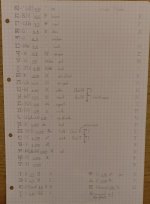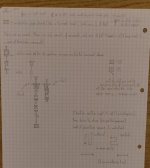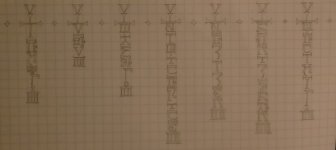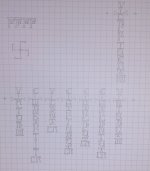Onbael_
Well-known member
I have been writing a new alphabet every now and then for months, mainly for fun, in the same way I approach creating art.
Over the course of time, I have peppered some symbols, also trying to build on existing alphabets and symbols as close as possible to the sound they represent, also looking at more archaic versions of the letters.
In other letters I put a bit of imagination into them, other letters I directly took from other alphabets, changing their sound or keeping them as they were.
The structure is based on the Greek alphabet, in the symbolism of the letters and their value. But I have also inserted other elements such as other sounds such as H aspirated, SH, TS and added optional variants of other letters such as sweet G, Ñ and the like, although for these I have retained the value of the original variant (it could be excluded in other types of calculation as a letter, more so and not to miss them).
The concept I have chosen is that there are only consonants, and each consonant has 15 variants, which are:
"Consonant + The 7 vowels (Ba), Consant + The 7 vowels in their long form (Baa), and The pure consonant (B) (the 7 vowels are the Greek ones)".
To use only vowels, the letter Alif is used, which by itself has no sound, but in its variants has only the vowel sound.
All letters are capital letters.
I will now briefly describe the letters:
The first letter is Alif, and its symbol is indentical to the sound Sa in Tibetan, mainly because I liked the symbol.
The B I took from one of the archaic variants of Beta.
The G is identical to Gamma.
D is a permutation of the Greek Delta, similar to D in Russian.
For H (aspirated), I gave it a smaller body, as one of those 'lighter', less full-bodied sounds.
For the V, I used an archaic variant of Vaw.
For the Z, I created a symbol similar to the Greek Zeta, the sound is that of a bee (bZZZ).
For TH I chose to use the symbol V, which is also the symbol for 5 in Roman. The 5 symbolises the elements and thus the whole, like the ether.
The corresponding Greek letter Theta is the letter symbolising the ether.
The letter I is the same as Iota, but elongated, simply because I liked it as a graphic choice. This letter is pronounced as the I of Jera, which is different from the variants with the vowel I, although the value is the same. This is the I of Jera, the other is the I of Thurisaz.
The letter K is a permutation of the Greek Kappa, the sound is the same.
The letter L is a permutation of the Greek Lambda, similar to the Russian L.
The letter M is identical to the Tibetan letter Ba, I only chose it because I liked it graphically.
The letter N is a permutation I created of the Tibetan letter Pha.
The letter SS is a permutation of the Greek Sigma. It is found in correspondence with Ksi, because it is the place of 'samek' which is SS, likewise the second permutation of this letter is Ksi.
The letter P is identical to Pi.
Doubtful about the variant that to the sound F, for example on B I have seen it pronounced V several times, but on F I have no clear reference.
The letter Q is identical to Greek Qoppa.
The sound is that of K but guttural.
The letter R is similar to the hebrew letter 'kof', although the idea is that it must resemble the Greek Rho. Otherwise it is also similar to the letter A in Japanese Katakana.
The letter SH is identical to the Russian SH.
The letter T is a fancy invention, similar to the lower case t.
I wanted at least one letter that was similar in appearance to G, but I am unsure about this letter, however it is F.
The letter KH is like a continuation of the letter H.
The letter PS is a decomposition of the Greek Psi. I am not completely sure about this letter.
For the letter TS, I don't have much explanation, it was one of the most beautiful symbols I had left. It reminds one of a 7.
For consonant variants, which always go under the slash indicating the variant, I have chosen:
For A, I originally used this symbol for Alif which was similar to the Arabic Alif, but then I simply kept it that way for simplicity and graphic beauty.
For Eta and Epsilon, I used these two symbols. I lacked ideas here, in the future I might change them. However they resemble an E.
For the I I kept the same I (J) as Jera, but this one is different anyway. The I of Jera is to be seen as a consonant.
For the O I used a symbol reminiscent of an eye.
For the U I used an upside-down Y, perhaps I will change it in the future.
For the O of Omega I kept the same symbol as the previous O, but instead of the circle there was a W similar to Omega in lower case. Now I have put a Russian symbol similar to SH, just for graphic beauty. I may change this in the future.
The symbol indicating the pure consonant is similar to the 'sword handle' above the word, but smaller.
For the symbol indicating a double or elongated vowel, I simply kept a symbol similar to the A for ease. This symbol goes to the left of the letter, unlike the accent symbol which goes to the right.
I also created four final variants of the letters SS (of SH), T, N, M, which have the appearance of an elongated Gamma. You can recognise them from the elementary symbol written below.
The purpose is not only to give graphic beauty to certain words, giving them the shape of the sword, but also to be able to write the name of Satan (STNM) in an encrypted manner for any eventuality.
These four letters in their final version when put together form a swastika.
The final version only applies to these sounds, the variants with Ñ and SH have no final version.
One of the last symbols I took directly from the hebrew 'second shin' and gave it a form closer to the Russian SH.
I read briefly about this letter on kabbalah exposed, and apparently its shape serves to visualise the energy manifested in the four elements and directions, and in the material world.
This symbol is in combination with V placed on top of the sword. The V symbol corresponds to TH, which corresponds to Theta, symbolising the Ether.
That brings the energy through the word to the material realm (manifestation).
Nothing related to hebrew in short, it is just a graphic way with which to represent this manifestation.
It is also possible to replace V with other letters, so as to use other elements or energies to manifest something. Here you just have to look at what each letter (planet, element or sign) symbolises, and work out how and whether to use it.
I have also tried to give the meaning to each letter as in the Phoenician alphabet, but I don't know much about it. You can also ignore that part.
For the rest, there are different orders in which to write the words, on the picture I mentioned that. The base however I took it from the planetary squares.
Finally there are dots at the beginning and end of a sentence for purely graphical purposes, although in the future they might have a use, such as containing runes or other symbols, but for now it's just for graphical beauty.
In the future I may update this system, certainly some letters I am unsure about I will change them, for the rest that is all.
I have called this system
'The Sword System'.
Over the course of time, I have peppered some symbols, also trying to build on existing alphabets and symbols as close as possible to the sound they represent, also looking at more archaic versions of the letters.
In other letters I put a bit of imagination into them, other letters I directly took from other alphabets, changing their sound or keeping them as they were.
The structure is based on the Greek alphabet, in the symbolism of the letters and their value. But I have also inserted other elements such as other sounds such as H aspirated, SH, TS and added optional variants of other letters such as sweet G, Ñ and the like, although for these I have retained the value of the original variant (it could be excluded in other types of calculation as a letter, more so and not to miss them).
The concept I have chosen is that there are only consonants, and each consonant has 15 variants, which are:
"Consonant + The 7 vowels (Ba), Consant + The 7 vowels in their long form (Baa), and The pure consonant (B) (the 7 vowels are the Greek ones)".
To use only vowels, the letter Alif is used, which by itself has no sound, but in its variants has only the vowel sound.
All letters are capital letters.
I will now briefly describe the letters:
The first letter is Alif, and its symbol is indentical to the sound Sa in Tibetan, mainly because I liked the symbol.
The B I took from one of the archaic variants of Beta.
The G is identical to Gamma.
D is a permutation of the Greek Delta, similar to D in Russian.
For H (aspirated), I gave it a smaller body, as one of those 'lighter', less full-bodied sounds.
For the V, I used an archaic variant of Vaw.
For the Z, I created a symbol similar to the Greek Zeta, the sound is that of a bee (bZZZ).
For TH I chose to use the symbol V, which is also the symbol for 5 in Roman. The 5 symbolises the elements and thus the whole, like the ether.
The corresponding Greek letter Theta is the letter symbolising the ether.
The letter I is the same as Iota, but elongated, simply because I liked it as a graphic choice. This letter is pronounced as the I of Jera, which is different from the variants with the vowel I, although the value is the same. This is the I of Jera, the other is the I of Thurisaz.
The letter K is a permutation of the Greek Kappa, the sound is the same.
The letter L is a permutation of the Greek Lambda, similar to the Russian L.
The letter M is identical to the Tibetan letter Ba, I only chose it because I liked it graphically.
The letter N is a permutation I created of the Tibetan letter Pha.
The letter SS is a permutation of the Greek Sigma. It is found in correspondence with Ksi, because it is the place of 'samek' which is SS, likewise the second permutation of this letter is Ksi.
The letter P is identical to Pi.
Doubtful about the variant that to the sound F, for example on B I have seen it pronounced V several times, but on F I have no clear reference.
The letter Q is identical to Greek Qoppa.
The sound is that of K but guttural.
The letter R is similar to the hebrew letter 'kof', although the idea is that it must resemble the Greek Rho. Otherwise it is also similar to the letter A in Japanese Katakana.
The letter SH is identical to the Russian SH.
The letter T is a fancy invention, similar to the lower case t.
I wanted at least one letter that was similar in appearance to G, but I am unsure about this letter, however it is F.
The letter KH is like a continuation of the letter H.
The letter PS is a decomposition of the Greek Psi. I am not completely sure about this letter.
For the letter TS, I don't have much explanation, it was one of the most beautiful symbols I had left. It reminds one of a 7.
For consonant variants, which always go under the slash indicating the variant, I have chosen:
For A, I originally used this symbol for Alif which was similar to the Arabic Alif, but then I simply kept it that way for simplicity and graphic beauty.
For Eta and Epsilon, I used these two symbols. I lacked ideas here, in the future I might change them. However they resemble an E.
For the I I kept the same I (J) as Jera, but this one is different anyway. The I of Jera is to be seen as a consonant.
For the O I used a symbol reminiscent of an eye.
For the U I used an upside-down Y, perhaps I will change it in the future.
For the O of Omega I kept the same symbol as the previous O, but instead of the circle there was a W similar to Omega in lower case. Now I have put a Russian symbol similar to SH, just for graphic beauty. I may change this in the future.
The symbol indicating the pure consonant is similar to the 'sword handle' above the word, but smaller.
For the symbol indicating a double or elongated vowel, I simply kept a symbol similar to the A for ease. This symbol goes to the left of the letter, unlike the accent symbol which goes to the right.
I also created four final variants of the letters SS (of SH), T, N, M, which have the appearance of an elongated Gamma. You can recognise them from the elementary symbol written below.
The purpose is not only to give graphic beauty to certain words, giving them the shape of the sword, but also to be able to write the name of Satan (STNM) in an encrypted manner for any eventuality.
These four letters in their final version when put together form a swastika.
The final version only applies to these sounds, the variants with Ñ and SH have no final version.
One of the last symbols I took directly from the hebrew 'second shin' and gave it a form closer to the Russian SH.
I read briefly about this letter on kabbalah exposed, and apparently its shape serves to visualise the energy manifested in the four elements and directions, and in the material world.
This symbol is in combination with V placed on top of the sword. The V symbol corresponds to TH, which corresponds to Theta, symbolising the Ether.
That brings the energy through the word to the material realm (manifestation).
Nothing related to hebrew in short, it is just a graphic way with which to represent this manifestation.
It is also possible to replace V with other letters, so as to use other elements or energies to manifest something. Here you just have to look at what each letter (planet, element or sign) symbolises, and work out how and whether to use it.
I have also tried to give the meaning to each letter as in the Phoenician alphabet, but I don't know much about it. You can also ignore that part.
For the rest, there are different orders in which to write the words, on the picture I mentioned that. The base however I took it from the planetary squares.
Finally there are dots at the beginning and end of a sentence for purely graphical purposes, although in the future they might have a use, such as containing runes or other symbols, but for now it's just for graphical beauty.
In the future I may update this system, certainly some letters I am unsure about I will change them, for the rest that is all.
I have called this system
'The Sword System'.






